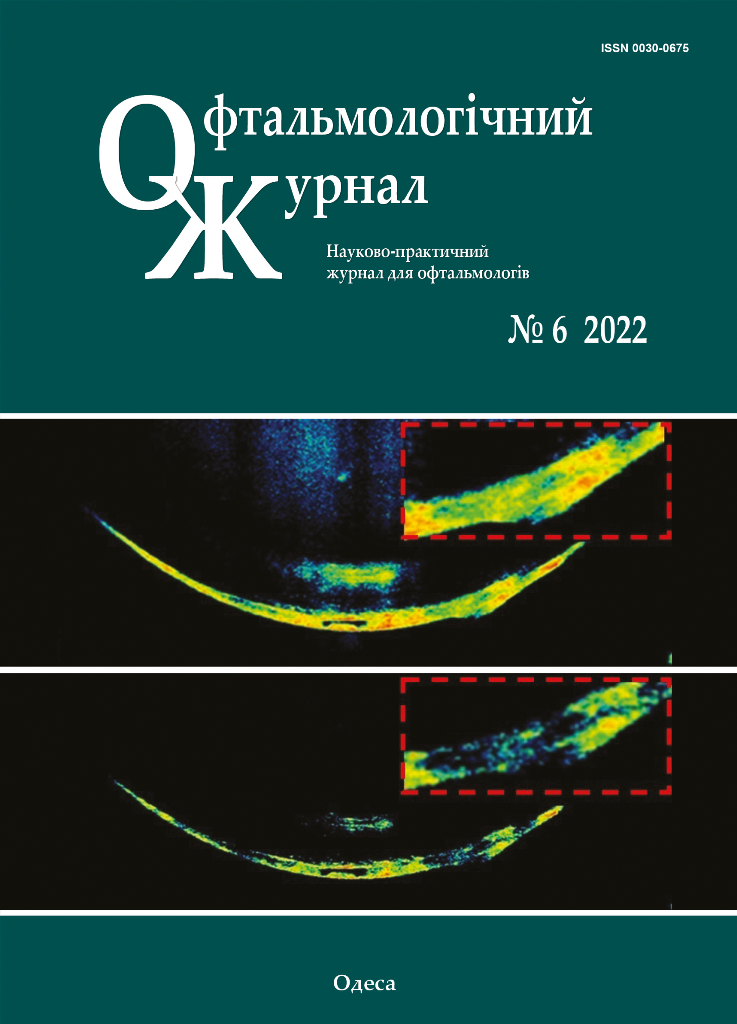Efficacy of exenteration of the orbit and sinus in malignant tumors of the ethmoidal labyrinth
DOI:
https://doi.org/10.31288/oftalmolzh202263538Keywords:
tumor of the ethmoidal labyrinth, exenteration of the orbit and sinusAbstract
Background: Diagnosing malignant tumors of the ethmoidal labyrinth early, with advanced techniques, is important, because late diagnosis may lead to intracranial spread to the eye or base of the skull.
Purpose: To assess the efficacy of exenteration of the orbit and sinus in the presence of the tumor of the ethmoidal labyrinth spreading to the eye.
Material and Methods: Sixty-two patients with a malignant tumor of the ethmoidal labyrinth spreading to the eye received surgery during 2017 through 2022. Of these, 42 (75.8%) were females and 20 (32.2%) were males, with patient age ranging from 55 to 75 years. Diagnostic assessment included computed tomography (CT) of the paranasal sinuses and orbit and tumor biopsy from the nasal cavity. Patients underwent a radical surgical procedure, an exenteration of the orbit and sinus. One month after surgery, they received preventive radiotherapy, with a dose of 40-45 Gy applied to the bed of the primary tumor.
Results: Intraoperative course was unremarkable, and no postoperative complications were found. All the patients (100%) showed no evidence of tumor recurrence or regrowth and no metastasis over a 6-month and 3-year follow-up.
Conclusion: A radical surgical procedure, an exenteration of the orbit and sinus followed by postoperative radiotherapy for a moderately differentiated tumor of the ethmoidal labyrinth spread to the orbit allowed achieving a positive treatment outcome, both in terms of local status (i.e., no tumor recurrence or regrowth) and disease process (no metastasis), over a 3-year follow-up in all the patients (100%). The decision of the extent of surgery should be made by a multispecialty team including an otorhinolaryngologist, eye cancer specialist and neurosurgeon.
References
1. Yevchev FD, Pukhlik SM, Gajevsky VV, et al. [Surgeon's strategy in urgent conditions of the head, cavities of the facial skeleton and neck]. Otorynolaryngologiia. 2019;2:22. Ukrainian.
2. Fedorenko ZP, Michailovich YY, Gouldk L, et al. [Cancer in Ukraine 2017-2018. Incidence, mortality, activities of the oncological service]. BULLETIN OF the NATIONAL CANCER REGISTRY OF UKRAINE Vol. 20. National Cancer Institute of Ukraine. Kyiv; 2019. Ukrainian.
3. [Uniform clinical protocol of primary, secondary (specialized) and tertiary (highly specialized) care. Order of the Ministry of Health of Ukraine No. 246 dated 28.03.2016]. Ukrainian.
4. Kovtunenko OV, Tymchuk SM, Bakaiev AA. [Surgical treatment of advanced cancer of the maxillary sinus]. Otorynolaryngologiia. 2019;2:41. Ukrainian.
5. Benazzou S, Arkha Y, Boulaadas M, Essakalli L, KzadriM. Orbital exenteration. Rev Stomatol Chir Maxillofac. 2011 Apr;112(2):69-74. doi: 10.1016/j.stomax.2011.01.003. Epub 2011 Feb 18. PMID:21334035 French. https://doi.org/10.1016/j.stomax.2011.01.003
6. Furdova A, Babal P, Zahorjanova P, Sekac J. Subtotal Exenteration of the Orbit for Benign Orbital Disease. J Craniofac Surg. 2020 Jul-Aug; 31(5): 1367-1369. https://doi.org/10.1097/SCS.0000000000006357
Downloads
Published
How to Cite
Issue
Section
License
Copyright (c) 2025 Ф. Д. Євчев, А. Ф. Євчева, В. В. Гаєвський, С. І. Полякова

This work is licensed under a Creative Commons Attribution 4.0 International License.
This work is licensed under a Creative Commons Attribution 4.0 International (CC BY 4.0) that allows users to read, download, copy, distribute, print, search, or link to the full texts of the articles, or use them for any other lawful purpose, without asking prior permission from the publisher or the author as long as they cite the source.
COPYRIGHT NOTICE
Authors who publish in this journal agree to the following terms:
- Authors hold copyright immediately after publication of their works and retain publishing rights without any restrictions.
- The copyright commencement date complies the publication date of the issue, where the article is included in.
DEPOSIT POLICY
- Authors are permitted and encouraged to post their work online (e.g., in institutional repositories or on their website) during the editorial process, as it can lead to productive exchanges, as well as earlier and greater citation of published work.
- Authors are able to enter into separate, additional contractual arrangements for the non-exclusive distribution of the journal's published version of the work with an acknowledgement of its initial publication in this journal.
- Post-print (post-refereeing manuscript version) and publisher's PDF-version self-archiving is allowed.
- Archiving the pre-print (pre-refereeing manuscript version) not allowed.












